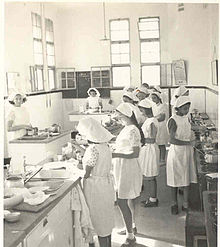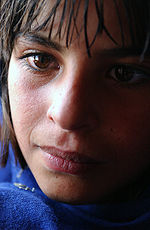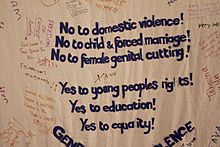Girl
The treatment and status of girls in any society is usually closely related to the status of women in that culture. In cultures where women have or had a low social position, girls may be unwanted by their parents, and society may invest less in girls. The difference in girls' and boys' upbringing ranges from slight to completely different. Mixing of the sexes may vary by age, and from totally mixed to total sex segregation.
Etymology
The English word girl first appeared during the Middle Ages between 1250 and 1300 CE and came from the Anglo-Saxon word gerle (also spelled girle or gurle). The Anglo-Saxon word gerela meaning dress or clothing item also seems to have been used as a metonym in some sense. Until the late 1400s, the word meant a child of either sex; it has meant 'female child' since about the late 15th century CE.
Usage for adult women
The word girl is sometimes used to refer to an adult female, usually a younger one. This usage may be considered derogatory or disrespectful in professional or other formal contexts, just as the term boy can be considered disparaging when applied to an adult man. Hence, this usage is often deprecative. It can also be used depreciatively when used to discriminate against children (e.g., "you're just a girl"). However, girl can also be a professional designation for a woman employed as a model or other public feminine representative such as a showgirl, and in such cases is not generally considered derogatory.
In a casual context, the word has positive uses, as evidenced by its use in titles of popular music. It has been used playfully for people acting in an energetic fashion (Canadian singer Nelly Furtado's "Promiscuous Girl") or as a way of unifying women of all ages on the basis of their once having been girls (American country singer Martina McBride's "This One's for the Girls").
History
The status of girls throughout world history is closely related to the status of women in any culture. Where women enjoy a more equal status with men, girls benefit from greater attention to their needs.
Girls' education
The examples and perspective in this section deal primarily with Europe and do not represent a worldwide view of the subject. (June 2024) |
Girls' formal education has traditionally been considered far less important than that of boys. In Europe, exceptions were rare before the printing press and the Reformation made literacy more widespread. One notable exception to the general neglect of girls' literacy is Queen Elizabeth I. In her case, as a child, she was in a precarious position as a possible heir to the throne, and her life was endangered by the political scheming of other powerful members of the court. Following the execution of her mother, Anne Boleyn, Elizabeth was considered illegitimate. Her education was for the most part ignored by Henry VIII. Henry VIII's widow, Catherine Parr, took an interest in the high intelligence of Elizabeth, and supported the decision to provide her with an impressive education after Henry's death, starting when Elizabeth was 9. Elizabeth received an education equal to that of a prominent male aristocrat; she was educated in Latin, Greek, Spanish, French, philosophy, history, mathematics and music. It has been argued that Elizabeth's education helped her grow up to become a successful monarch.
By the eighteenth century, Europeans recognized the value of literacy, and schools were opened to educate the public in growing numbers. Education in the Age of Enlightenment in France led to up to a third of women becoming literate by the time of the French Revolution, contrasting with roughly half of men by that time. However, education was still not considered as important for girls as for boys, who were being trained for professions that remained closed to women, and girls were not admitted to secondary level schools in France until the late 19th century. Girls were not entitled to receive a Baccalaureate diploma in France until the reforms of 1924 under education minister Léon Bérard. Schools were segregated in France until the end of World War II. Since then, compulsory education laws have raised the education of girls and young women throughout Europe. In many European countries, girls' education was restricted until the 1970s, especially at higher levels. This was often done by teaching different subjects to each sex, especially since tertiary education was considered primarily for males, particularly with regard to technical education. For example, prestigious engineering schools, such as École Polytechnique, did not allow women until the 1970s.
-
La lettrice (1856). Reading Girl, sculpture by Pietro Magni
-
Princess Neferure as a girl, sitting on the lap of her tutor Senenmut. Girls and women in Ancient Egypt enjoyed a relatively high social status.
-
Two Finnish girls at the Hailuoto Island in 1912
"Coming of age" customs
This section needs additional citations for verification. (January 2022) |
Many cultures have traditional customs to mark the "coming of age" of a girl or boy, to recognize their transition to adulthood, or to mark other milestones of their journey to maturity as children.
Japan has a coming-of-age ritual called Shichi-Go-San (七五三), which literally means "Seven-Five-Three". This is a traditional rite of passage and festival day in Japan for three- and seven-year-old girls and three- and five-year-old boys, held annually on November 15. It is generally observed on the nearest weekend. On this day, the girl will be dressed in a traditional kimono, and will be taken to a temple by her family for a blessing ceremony. Nowadays, the occasion is also marked with a formal photo portrait.
Many coming-of-age ceremonies are to acknowledge the passing of a girl through puberty, when she experiences menarche, or her first menstruation. The traditional Apache coming-of-age ceremony for girls is called the na'ii'ees (Sunrise Ceremony), and takes place over four days. The girls are painted with clay and pollen, which they must not wash off until the end of the rituals, which involve dancing and rituals that challenge physical strength. Girls are taught aspects of sexuality, confidence, and healing ability. The girls pray in the direction of the east at dawn, and in the four cardinal directions, which represent the four stages of life. This ceremony was banned by the U.S. government for many decades; after being decriminalized by the Indian Religious Freedom Act in 1978, it has seen a revival.
Some coming-of-age ceremonies are religious rituals to recognize a girl's maturity with respect to her understanding of religious beliefs, and her changing role in her religious community. Confirmation is a ceremony common to many Christian denominations for both boys and girls, usually taking place when the child is in their teen years. In Roman Catholic communities, Confirmation is considered one of seven sacraments that a Catholic may receive. In many countries, it is traditional for Catholics children to receive another sacrament, First Communion, at the age of seven. The sacrament is usually performed in a church once a year, with children who are of age receive a blessing from a bishop in a special ceremony. It is traditional in many countries for Catholic girls to wear white dresses and possibly a small veil or wreath of flowers in their hair to their First Communion. The white dress symbolizes spiritual purity.
A traditional coming-of-age ritual for daughters of college age (17 to 21 years old) from high society and well-connected upper-class and White Anglo-Saxon Protestant (WASP) families in North America and Europe has historically been their debut, known as "coming out," at a debutante ball, such as the International Debutante Ball in New York City. Traditionally, debutantes wear couture white gowns and gloves symbolising purity and wealth.
Across Latin America, the fiesta de quince años is a celebration of a girl's fifteenth birthday. The girl celebrating the birthday is called a Quinceañera. This birthday is celebrated differently from any other birthday, as it marks the transition from childhood to womanhood.
While completely secular in nature, a girl’s first bra is sometimes seen as an important next step in her life. Unlike many more traditional coming of age customs, the event has no set date in a girl’s life and can occur when she is a teenager and in other times can occur when she is a preteen.
-
58th International Debutante Ball, 2012, New York City (Waldorf-Astoria Hotel)
-
Bat mitzvah in Israel
-
A seven-year old girl dressed for Shichi-Go-San
Preparing girls for marriage
This section needs additional citations for verification. (January 2022) |

In many ancient societies, girls' upbringing had much to do with preparing them to be future wives. In many cultures, it was not the norm for women to be economically independent. Thus, where a girl's future well-being depended upon marrying her to a man who was economically self-sufficient, it was crucial to prepare her to meet whatever qualities or skills were popularly expected of wives.
Western society
In cultures ranging from Ancient Greece to the twentieth-century United States, girls were taught essential domestic skills including sewing, cooking, gardening and basic hygiene, and medical care such as preparing balms and salves, and in some cases midwifery. These skills were passed orally from generation to generation, with the knowledge passed down orally from mother to daughter. A well-known reference to these important women's skills is in the folk tale Rumpelstiltskin, which dates back to medieval Germany and was collected in written form by the folklorists the Brothers Grimm. The miller's daughter is valued as a potential wife because of her reputation for being able to spin straw into gold.
China
In some parts of China, beginning in the Southern Tang kingdom in Nanjing (937–975), the custom of foot binding was associated with upper-class women who were worthy of a life of leisure, and husbands who could afford to spare them the necessity of work (which would require the ability to be mobile and spend the day on their feet). Because of this belief, parents hoping to ensure a good marriage for their daughters would begin binding their feet from about the age of 5–8 to achieve the ideal appearance. The tinier the feet, the better the social rank of a future husband. The practice started seriously to decline in the early years of the twentieth century, and was all but extinct by 1950.
China has had many customs relating to girls and their roles as future wives and mothers.
Traditionally an unmarried girl would wear her hair in two pigtails, and once married, in one.
Africa
In some cultures, girls' passing through puberty is viewed with concern for a girl's chastity. In some communities, there is a traditional belief that female genital mutilation is a necessity to prevent a girl from becoming sexually promiscuous. The practice is dangerous, however, and leads to long-term health problems for women who have undergone it. The practice has been a custom in 28 countries of Africa, and persists mainly in rural areas. This coming-of-age custom, sometimes incorrectly described as "female circumcision", is being outlawed by governments, and challenged by human rights groups and other concerned community members, who are working to end the practice.
Trafficking and trading girls


Girls have been used historically, and are still used in some parts of the world, in settlements of disputes between families, through practices such as baad, swara, or vani. In such situations, a girl from a criminal's family is given to the victim's family as a servant or a bride. Another practice is that of selling girls in exchange for the bride price. The 1956 Supplementary Convention on the Abolition of Slavery, the Slave Trade, and Institutions and Practices Similar to Slavery defines "institutions and practices similar to slavery" to include: c) Any institution or practice whereby: (i) A woman, without the right to refuse, is promised or given in marriage on payment of a consideration in money or in kind to her parents, guardian, family or any other person or group; or (ii) The husband of a woman, his family, or his clan, has the right to transfer her to another person for value received or otherwise; or (iii) A woman on the death of her husband is liable to be inherited by another person.
Demographics



Scholars are unclear and in dispute as to possible causes for variations in human sex ratios at birth. Countries which have sex ratios of 108 and above are usually presumed as engaging in sex selection. However, deviations in sex ratios at birth can occur for natural causes too. Nevertheless, the practice of bias against girls, through sex-selective abortion, female infanticide, female abandonment, as well as favouring sons with regard to allocating of family resources is well documented in parts of South Asia, East Asia, and the Caucasus. Such practices are a major concern in China, India and Pakistan. In these cultures, the low status of women creates a bias against females.
China and India have a very strong son preference. In China, the one-child policy was largely responsible for an unbalanced sex ratio. Sex-selective abortion, as well as rejection of girl children is common. The Dying Rooms is a 1995 television documentary film about Chinese state orphanages, which documented how parents abandoned their newborn girls into orphanages, where the staff would leave the children in rooms to die of thirst, or starvation. In India, the practice of dowry is partly responsible for a strong son preference. Another manifestation of son preference is the violence inflicted against mothers who give birth to girls.
In India, by 2011, there were 91 girls younger than 6 for every 100 boys. Its 2011 census showed that the ratio of girls to boys under the age of 6 years old has dropped even during the past decade, from 927 girls for every 1000 boys in 2001 to 918 girls for every 1000 boys in 2011. In China, scholars report 794 baby girls for every 1000 baby boys in rural regions. In Azerbaijan, last 20 years of birth data suggests 862 girls were born for every 1000 boys, on average every year. Steven Mosher, president of the Population Research Institute in Washington, D.C., has said: "Twenty-five million men in China currently can't find brides because there is a shortage of women [...] young men emigrate overseas to find brides." The gender imbalance in these regions is also blamed for spurring growth in the commercial sex trade; the UN's 2005 report states that up to 800,000 people being trafficked across borders each year, and as many as 80 percent are women and girls.
Biology


Embryos that inherit two X chromosomes (XX), one from each parent, are generally identified as girls when born.
About one in a thousand girls have a 47,XXX karyotype, and one in 2500 have a 45,X one.
Girls typically have a female reproductive system. Some intersex children with ambiguous genitals may be classified as girls, while some Transgender youth have a gender identity as girls.
Girls' bodies undergo gradual changes during puberty. Puberty is the process of physical changes by which a child's body matures into an adult body capable of sexual reproduction to enable fertilization. It is initiated by hormonal signals from the brain to the gonads. In response to the signals, the gonads produce hormones that stimulate libido and the growth, function, and transformation of the brain, bones, muscle, blood, skin, hair, breasts, and sexual organs. Physical growth—height and weight—accelerates in the first half of puberty and is completed when the child has developed an adult body. Until the maturation of their reproductive capabilities, the pre-pubertal, physical differences between boys and girls are the genitalia. Puberty is a process that usually takes place between 10 and 16 years, but these ages differ from person to person. The major landmark of female puberty is menarche, the onset of menstruation, which occurs on average between 12 and 13. According to a 2010 Canadian study, the variation of age in which menstruation begins had a "statistically significant" relation to where the child was living, household income, and family type.
Gender and environment

Biological sex interacts with environment in ways not fully understood. Identical twin girls separated at birth and reunited decades later have shown both startling similarities and differences. In 2005, professor Kim Wallen of Emory University noted, "I think the 'nature versus nurture' question is not meaningful, because it treats them as independent factors, whereas in fact everything is nature and nurture."
Femininity is a set of attributes, behaviours, and roles generally associated with girls and women. Femininity is socially constructed, but made up of both socially-defined and biologically created factors. This makes it distinct from the definition of the biological female sex, as both males and females can exhibit feminine traits. Traits traditionally cited as feminine include gentleness, empathy, and sensitivity, though traits associated with femininity vary depending on location and context, and are influenced by a variety of social and cultural factors.
Gender neutrality describes the idea that policies, language, and other social institutions should avoid distinguishing roles according to people's sex or gender, in order to avoid discrimination arising from rigid gender roles. Unisex refers to things that are considered appropriate for any sex. Campaigns for unisex toys include Let Toys Be Toys.
Teenage pregnancy
Teenage pregnancy is pregnancy in an adolescent girl. A female can become pregnant from sexual intercourse after she has begun to ovulate. Pregnant teenagers face many of the same pregnancy related issues as other women. There are, however, additional concerns for young adolescents as they are less likely to be physically developed enough to sustain a healthy pregnancy or to give birth.
In developed countries, teenage pregnancy is usually associated with social issues, including lower educational levels, poverty, and other negative life outcomes; and often carries a social stigma. By contrast, teenage girls in developing countries are often married, and their pregnancies welcomed by family and society. However, in these societies, child marriage and early pregnancy often combine with malnutrition and poor health care and create medical problems.

















